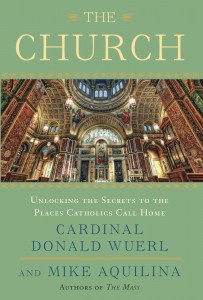
Reviewed by Brian T. Olszewski
Cardinal Donald W. Wuerl of Washington and Mike Aquilina have discovered a simple but effective way to teach Catholics about Catholicism. Replicating the formula used in their 2011 book, “The Mass: The Glory, the Mystery, the Tradition,” the co-authors explain what is inside the church building and why it is there.
That formula is a combination of material culled from Scripture, church history, the documents of the Second Vatican Council and the Catechism of the Catholic Church. Blending it with their narrative of what comprises a church building, and they provide readers a quick course in church architecture and furnishings.
They start by making a connection between, and explaining the difference between, “a” church, i.e., building, and “the” church, i.e., people of God, and then walk readers through the edifice, explaining — sometimes in a couple of pages, sometimes in as many as seven — what they’ll find.
Things churchgoers see but to which they might not have given much thought, e.g., doors, sacristy, stained glass, tabernacle, confessional, are featured. As an aside, in the chapter featuring the “confessional,” the phrase “sacrament of reconciliation” is used once, but the confessional is not referred to as a “reconciliation room.” Those who have never seen the booth-type confessional prevalent in older churches, or who have been catechized with the term “reconciliation room,” may be confused.
Each chapter will provide the nonscholarly Catholic with material that might evoke an “I didn’t know that” response. However, one chapter that might be considered “fun” is the one devoted to symbols and abbreviations. Ankh? IC XC? Just two of the symbols and words the authors explain. (The former is an Egyptian “looped cross” that represents the crucified Christ; the latter is an abbreviation for the name of Jesus.)
What is useful for those wishing to do more study is the “for further reading” list that includes other books by the authors, but, relevant to the subject of this book, documents that pertain directly to the structure of a church building.
“The Church” lends itself to individual education and group study/discussion. As “the” church, especially at the parish level, focuses upon new evangelization — an evangelization that includes those already in the pews — it would do well to use this book as part of its Rite of Christian Initiation of Adults program and as a text for an adult faith-formation program.
Whether used alone or in tandem with the aforementioned “The Mass,” it is possible that as participants read about holy water fonts, shapes, bells, candles and other parts of the building, they will become a more knowledgeable, and maybe even faith-filled, church — “the” church. – CNS